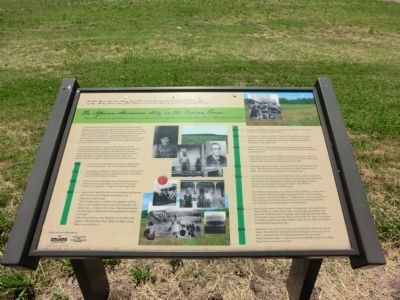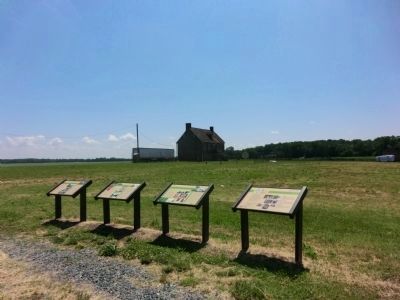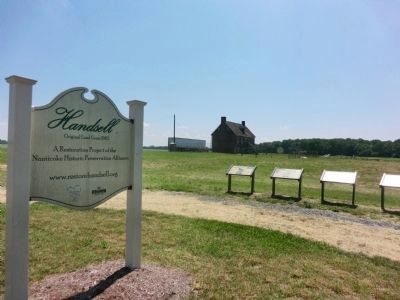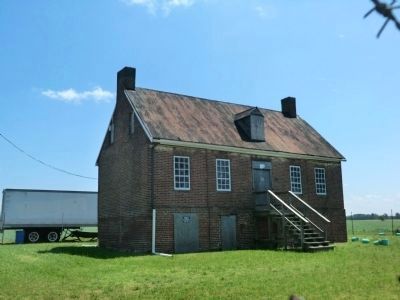Near Vienna in Dorchester County, Maryland — The American Northeast (Mid-Atlantic)
The African American Story in the Indian Town
“When I am homesick, I just call up rene in my dreams and I’am right back home in the Indian Town.” Gloria Robinson Walter.
It is clear that from the early days on both white and black families lived in the Indiantown as a plantation community, with free blacks working on the farms side by side with enslaved people. Many of the slaves and freeman were related and their descendants continued to reside in Indiantown Road through the 1950’s. Living family members have provided photographs that help to reconstruct life as it was here in the 20th century. All structures that you see in these old photographs, including former slave houses, sheds and barns have been demolished except for Handsell.
Uncovering data from historic documents such as death inventories, manumission papers, deeds and Wills can provide important information to reveal the story of those descended from the Indiantown community. Comparing names and ages of listed persons helps to identify not only a specific individual but sometimes family connections as well. This timeline shows a few samples of what can be learned from this research.
1749-As the sole surviving child of her parents, Ann Billings Steele inherited several slaves. One was a young girl named Nell.
1776-According to the Maryland Colonial Census Henry Steele (and his wife Ann Billings) lived in the Nanticoke District of Dorchester County with his family and 91 slaves.
1782-When Henry Steele died, three slaves were treated by medical Dr. Gordon who charged debits to Henry Steele’s estate for treatment of Negro Isaac, a Negro Man and a Negro child.
1803-James Steele signed the first of several annual agreements with Overseer Levin Simmons at his farm in the Indiantown which states: “Levin Simmons agrees to continue in the employment of James Steele as Overseer during the present year at his plantation in the Indian Town…also that he will see that a Negro woman intended to be kept mostly at spinning does follow and perform her business as she ought.” Other slaves listed to assist Simmons on the farm were Stephon, Bill, Jim, John, Dick, Hicks, old Dido, young Dido, Lucy and Mary.
1803-On January 20, 1803 Isaac Steele granted freedom to Negro Levi, with a receipt for $36.50 “in full balance for his freedom”, 1810-Levin Simmons, overseer, is listed as living in the Vienna District with family and 27 slaves. John C. Henry, James Steele’s son-in-law, was also living in the Indiantown with two other females and 52 slaves. Both Henry and Steele owned parts of the Handsell tract.
1814-In Deed 3 ER 114, James Steele released from slavery and forever manumits William, age 28, son of
Sarah for $1, Witnessed and sworn by Richard Pattison and John C. Henry. Charles Jackson, born a slave in 1814 was the paternal ancestor of the Jackson family who lived and worked on Indiantown farms into the 1950’s. Who owned Charles is still a mystery, but we know he was freed by 1860.
1837-Handsell was sold to John Steele of Dorchester County, who rebuilt the brick house. The 1840 Census indicates he lived in the Vienna District with his family. Also listed in his household were 3 free black males.
1850-The 1850 Federal Census lists John Nevett Steele, white, widower, living in the Indiantown with his three sons. He lived in a house just up and cross the road from Handsell. Also listed in the household were Charity Jackson, age 37, “mulatto” and her daughter Fanny, age 8 months. The 1850 Slave Schedules also lists 26 slaves owned by Steele. The 1850 Slave Schedule lists free black man Thomas Pinder as a slave owner. He owned one female, age 45 and two girls ages 8 and 6. It is assumed that these were his wife and two daughters. During this time it was not unusual for a free black man to keep his family enslaved as a way of protecting them from being kidnapped and sold into slavery in the deep south.
1854-After his death, slaves of John N. Steele, “of Indiantown” were transferred to “James B. Steele, son of James Steele of Henry…do grant bargain
and sell unto the said James Steele…the following negroes to wit Joshua, Lucy, Daniel, Marshall, Hooper, Moses, Charles Littleton, Henry, John Nace, Mary, Elizabeth, and her three children, Sarah and her three children, Jack Wesley and another, Margaret and her Son Isaac, Maria and Nancy her child and Lilly all being Slaves for life…”
1859-Handsell was sold to John Thompson who is listed in the 1860 Census, age 73, farmer. The 1860 Slave Schedule listed John Thompson as the owner of 10 slaves. During this time the underground railroad was most active. Harriet Tubman is known to have used the Nanticoke River and/ or the Marshy Hope Creek as a route to the north.
Erected by Maryland Heritage Area Authority.
Topics. This historical marker is listed in these topic lists: African Americans • Agriculture • Colonial Era. A significant historical date for this entry is January 20, 1935.
Location. 38° 30.545′ N, 75° 48.767′ W. Marker is near Vienna, Maryland, in Dorchester County. Marker is on Indiantown Road, on the right when traveling north. Touch for map. Marker is at or near this postal address: 4837 Indiantown Rd, Vienna MD 21869, United States of America. Touch for directions.
Other nearby markers. At least 8 other markers are within 2 miles of this marker, measured as the crow flies. The native people of the Chicacone Village…the Nanticokes (here, next to this marker); Handsell (here, next to this marker);
The Nanticoke Historic Preservation Alliance (here, next to this marker); Unnacokossimmon (approx. 1.7 miles away); John Smith Explores the Chesapeake (approx. 1.7 miles away); Discover: Vienna Heritage (approx. 1.8 miles away); A walking tour of Vienna (approx. 1.9 miles away); Discover: Restoration (approx. 1.9 miles away). Touch for a list and map of all markers in Vienna.
Credits. This page was last revised on January 15, 2022. It was originally submitted on July 9, 2013, by Don Morfe of Baltimore, Maryland. This page has been viewed 845 times since then and 47 times this year. Photos: 1, 2, 3, 4. submitted on July 9, 2013, by Don Morfe of Baltimore, Maryland. • Bill Pfingsten was the editor who published this page.



